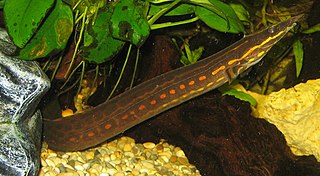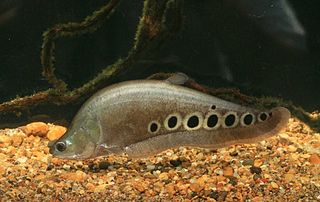
The Indian cormorant or Indian shag is a member of the cormorant family. It is found mainly along the inland waters of the Indian Subcontinent but extends west to Sind and east to Thailand and Cambodia. It is a gregarious species that can be easily distinguished from the similar sized little cormorant by its blue eyes, small head with a sloping forehead and a long narrow bill ending in a hooked tip.

The grey-headed fish eagle is a fish-eating bird of prey from Southeast Asia. It is a large stocky raptor with adults having dark brown upper body, grey head and lighter underbelly and white legs. Juveniles are paler with darker streaking. It is often confused with the lesser fish eagle and the Pallas's fish eagle. The lesser fish eagle is similar in plumage but smaller and the Pallas's fish eagle shares the same habitat and feeding behaviour but is larger with longer wings and darker underparts. Is often called tank eagle in Sri Lanka due to its fondness for irrigation tanks.

The iridescent shark or iridescent shark catfish is a species of shark catfish native to the rivers of Southeast Asia. Despite its name, it is not a shark. It is found in the Mekong basin as well as the Chao Phraya River, and is heavily cultivated for food there.

The Mekong giant catfish, is a large, threatened species of catfish in the shark catfish family (Pangasiidae), native to the Mekong basin in Southeast Asia and adjacent China. It is considered critically endangered due to overfishing and habitat loss.

The red-headed vulture, also known as the Asian king vulture, Indian black vulture or Pondicherry vulture, is an Old World vulture mainly found in the Indian subcontinent, with small disjunct populations in some parts of Southeast Asia.

The lesser fish eagle is a species of Icthyophaga found in the Indian subcontinent, primarily in the foothills of the Himalayas, and south-east Asia. There are records from Gujarat, Central India and in more recent times from the Kaveri river valley in southern India, although the south Indian records are now thought to come from an isolated population, disjunct from the species' normal range. Some taxonomic authorities place this species in the monotypic genus Icthyophaga. Others place it in the genus Haliaeetus.

The silver carp or silverfin is a species of freshwater cyprinid fish, a variety of Asian carp native to China and eastern Siberia, from the Amur River drainage in the north to the Xi Jiang River drainage in the south. Although a threatened species in its natural habitat, it has long been cultivated in China as one of the "Four Famous Domestic Fish" (四大家鱼) together with Bighead carp, Black carp and Grass carp. By weight, more silver carp are produced worldwide in aquaculture than any other species of fish except for the grass carp. Silver carp are usually farmed in polyculture with other Asian carp, or sometimes with catla or other shark species.

The giant barb, Siamese Giant carp, or simply Siamese carp is the largest species of cyprinid in the world. These migratory fish are found only in the Mae Klong, Mekong, and Chao Phraya River basins in Indochina. Populations have declined drastically due to habitat loss and overfishing, and the giant barb is now considered critically endangered.

The fire eel is a relatively large species of spiny eel. This omnivorous freshwater fish is native to Southeast Asia but is also found in the aquarium trade. Although it has declined locally due to overfishing, it remains common overall.

The clown featherback, also known as the clown knifefish and spotted knifefish, is a nocturnal species of tropical fish with a long, knife-like body. This knifefish is native to freshwater habitats in Cambodia, China, Hong Kong, Laos, Macau, Thailand, and Vietnam, but it has also been introduced to regions outside its native range. It is one of the world's most invasive species.

The Cambodian logsucker, also known as stonelapping minnow or false Siamese algae eater, is a species of ray-finned fish in the genus Garra. It lives in Southeast Asia.

Gyrinocheilus aymonieri is a freshwater fish native to large parts of Southeast Asia. It is of interest as a local food source and for the aquarium trade. Its common names include honey sucker, sucking loach and Chinese algae eater.
Paralaubuca s a genus of freshwater ray-finned fish belonging to the family Xenocyprididae, the East Asian minnows or sharpbellies. The species in this genus are found in Asia.

Cosmochilus harmandi is a species of freshwater fish belonging to the family of Cyprinidae. It is restricted to the Mekong and Chao Phraya rivers in Asia. It reaches up to 1 m (3.3 ft) in total length, but typically is about one-third that size. This widespread species is an important food fish.
Parachela maculicauda is a species of freshwater ray-finned fish belonging to the family Xenocyprididae, the East Asian minnows or sharpbellies. It occurs in lowland rivers and swamps in small groups. Found at the water surface in small and medium-sized rivers with nearby areas of floodplain forest. Feeds on plankton. It is found in the basins of the Mekong River and Chao Praya as well as the Malay Peninsula and on the island of Sumatra and in Sarawak, it has also been possibly recorded from the Mae Klong It is a small fish growing to a maximum length of 6 cm and is characterised by two blotches near the tips of each lobe of the caudal fin. It is of limited interest in fisheries but is used to make prahok. It is also of little interest to the aquarium trade.
Parachela siamensis is a species of freshwater ray-finned fish belonging to the family Xenocyprididae, the East Asian minnows or sharpbellies. This species is found in mainland Southeast Asia.
Paralaubuca riveroi is a species of freshwater ray-finned fish belonging to the family Xenocyprididae, the East Asian minnows or sharpbellies. This fish occurs in Southeast Asia.
Paralaubuca typusis a species of freshwater ray-finned fish belonging to the family Xenocyprididae, the East Asian minnows or sharpbellies. This fish occurs in south-east Asia. It is found in Thailand in the basins of the Chao Phraya, Tapi, Mekong and Mae Klong and in the Mekong on Laos and Cambodia, as well as Vietnam where it is also found in the La Ngà River. It is one of the most abundant fish species in the lower Mekong.

Leptobarbus rubripinna, also known as the Sultan barb, is a species of freshwater ray-finned fish from the carp and minnow family, Cyprinidae which occurs in south-east Asia.
Paralaubuca barroni is a species of freshwater ray-finned fish from the family Xenocyprididae, the East Asian minnows or sharpbellies, from south east Asia. It occurs in the Mekong and Chao Praya drainages in China, Thailand, Cambodia, Myanmar, and Vietnam.














